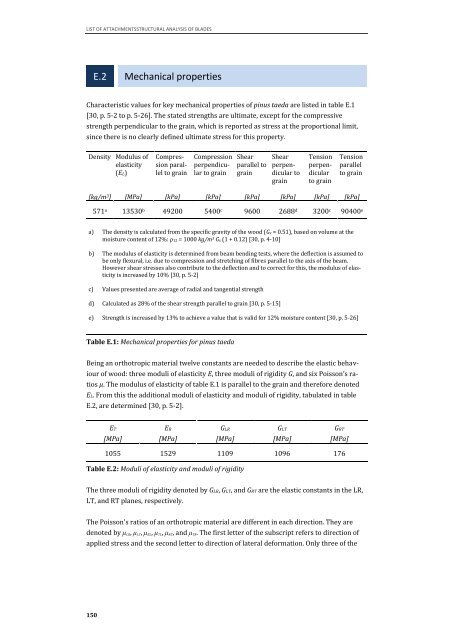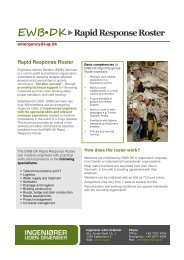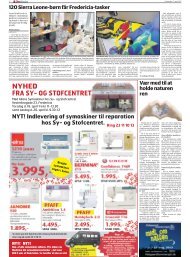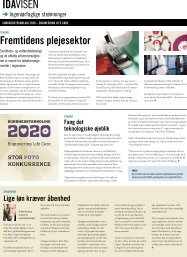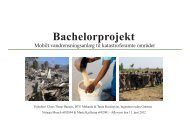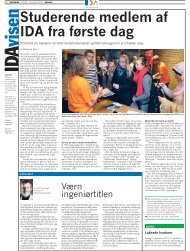You also want an ePaper? Increase the reach of your titles
YUMPU automatically turns print PDFs into web optimized ePapers that Google loves.
LIST OF ATTACHMENTSSTRUCTURAL ANALYSIS OF BLADES<br />
150<br />
E.2 Mechanical properties<br />
Characteristic values for key mechanical properties of pinus taeda are listed in table E.1<br />
[30, p. 5-2 to p. 5-26]. The stated strengths are ultimate, except for the compressive<br />
strength perpendicular to the grain, which is reported as stress at the proportional limit,<br />
<strong>sin</strong>ce there is no clearly defined ultimate stress for this property.<br />
Density<br />
[kg/m 3]<br />
Modulus of<br />
elasticity<br />
(EL)<br />
[MPa]<br />
Compressionparallel<br />
to grain<br />
[kPa]<br />
Compression<br />
perpendicular<br />
to grain<br />
[kPa]<br />
Shear<br />
parallel to<br />
grain<br />
[kPa]<br />
Shear<br />
perpendicular<br />
to<br />
grain<br />
[kPa]<br />
Tension<br />
perpendicular<br />
to grain<br />
[kPa]<br />
Tension<br />
parallel<br />
to grain<br />
[kPa]<br />
571 a 13530 b 49200 5400 c 9600 2688 d 3200 c 90400 e<br />
a) The density is calculated from the specific gravity of the wood (Gx = 0.51), based on volume at the<br />
moisture content of 12%: �12 = 1000 kg/m 3 Gx (1 + 0.12) [30, p. 4-10]<br />
b) The modulus of elasticity is determined from beam bending tests, where the deflection is assumed to<br />
be only flexural, i.e. due to compression and stretching of fibres parallel to the axis of the beam.<br />
However shear stresses also contribute to the deflection and to correct for this, the modulus of elasticity<br />
is increased by 10% [30, p. 5-2]<br />
c) Values presented are average of radial and tangential strength<br />
d) Calculated as 28% of the shear strength parallel to grain [30, p. 5-15]<br />
e) Strength is increased by 13% to achieve a value that is valid for 12% moisture content [30, p. 5-26]<br />
Table E.1: Mechanical properties for pinus taeda<br />
Being an orthotropic material twelve constants are needed to describe the elastic behav-<br />
iour of wood: three moduli of elasticity E, three moduli of rigidity G, and six Poisson’s ra-<br />
tios μ. The modulus of elasticity of table E.1 is parallel to the grain and therefore denoted<br />
EL. From this the additional moduli of elasticity and moduli of rigidity, tabulated in table<br />
E.2, are determined [30, p. 5-2].<br />
ET<br />
[MPa]<br />
ER<br />
[MPa]<br />
GLR<br />
[MPa]<br />
GLT<br />
[MPa]<br />
GRT<br />
[MPa]<br />
1055 1529 1109 1096 176<br />
Table E.2: Moduli of elasticity and moduli of rigidity<br />
The three moduli of rigidity denoted by GLR, GLT, and GRT are the elastic constants in the LR,<br />
LT, and RT planes, respectively.<br />
The Poisson's ratios of an orthotropic material are different in each direction. They are<br />
denoted by μLR, μLT, μRL, μTL, μRT, and μTR. The first letter of the subscript refers to direction of<br />
applied stress and the second letter to direction of lateral deformation. Only three of the


